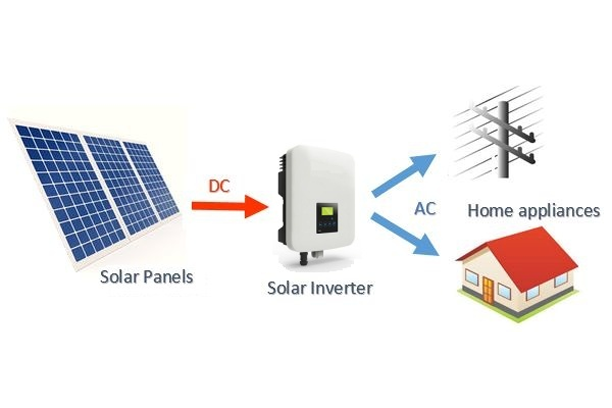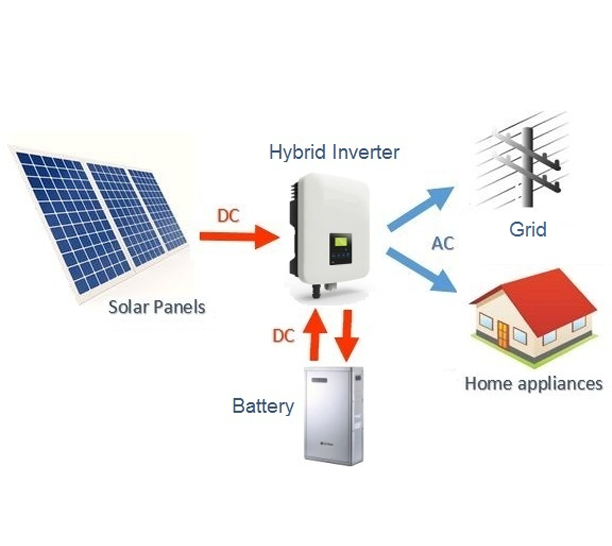Grid Solutions
On-Grid - also Known as a Grid-Tie or Grid-Feed Solar System
On-grid solar power system is a solar power generation system where it is connected to the CEB or LECO The electricity produced by the system is routed to the grid from where it is used to run the various appliances. The installation of the same is also fuss-free and easy to maintain.
The arrangement of solar modules absorbs the sunlight on them and convert them into electricity. The current generated here is Direct Current (DC). The solar inverter then converts the DC to Alternating Current (AC), thus making it power the electrical items. This electricity is then routed to the grid where it is supplied for day to day use. An important feature is a net meter. It is a device that records the energy supplied to the grid and the energy consumed. At the end of each month, the outstanding is recorded and the consumer is provided with a bill.

Net Metering
The customer generates electricity using solar panels fixed on their rooftops which are connected to the grid through a net metering system. The consumer has to pay only for the net amount of electricity that was consumed. If the solar electricity production exceeds the electricity consumption of the premises, the balance amount can be carried forward to future use upto 10 years. No fee will be paid for the excess electricity produced. Existing net metering customers can switch to other schemes if they wish to. However, the accumulated electricity units prior to the signing of new agreement shall not be carried forward.
Net Accounting
If the electricity generation of solar rooftop system is greater than the consumption, the consumer will be paid for the excess according to the below table. If the consumption is greater than the generation, the consumer shall pay for the excess consumption according to the existing electricity tariff.
Net Plus
The total electricity generation from the solar rooftop system would be purchased by the utility. The bill for electricity consumption would be paid to the utility as usual.
The utility would pay the solar electricity producers for the excess electricity exported to the grid on following basis with effect from the date of agreement signed with the utility.
Period LKR/kWh First 7 years at 22.00 8th to 20th year at 15.50
The installed capacity of the Generating Facility shall not exceed the Contract Demand of the Producer. The contract period is 20 years
.png)
Off-Grid - also Known as a Stand-Alone Power System (SAPS)
The solar panels generate direct current energy which is then connected to a Charge Controller to charge a set of batteries and stored in those rechargeable batteries. When energy is required, the direct current is sent from the battery to the stand-alone inverter and then converted into alternating current which can then be used to power a home or for any other electricity needs. These inverters are necessary for locations where no local power grid is available, or for anyone who wishes to remain completely independent of energy companies. It must be kept in mind that these systems are a very expensive option compared to the grid served electricity and comes up with a significant maintenance burden from the battery bank. With a stand-alone system, you will be unaffected by power outages because your system will be completely independent of the power grid. You will be free to consume electricity whenever you wish, provided your batteries are charged or your solar array is currently producing electricity
When the utility power is unavailable or too expensive to bring in to your home, solar panels allow you to be your own utility company! You can live in peace, with no noisy gas generator to disturb the quiet. There are several variations of off-grid solar power, depending on your needs and budget. All variations of off-grid solar power depend on solar electric panels, Inverter, and the stored electricity in the battery bank.
Hybrid - grid-connected solar system with battery storage
Hybrid solar systems generate power in the same way as a common grid-tie solar system but use special hybrid inverters and batteries to store energy for later use. This ability to store energy enables most hybrid systems to also operate as a backup power supply during a blackout, similar to a UPS system.
Traditionally the term hybrid referred to two generation sources such as wind and solar, but in the solar world, the term 'hybrid' refers to a system which uses a combination of solar and batteries that can interact with the electricity grid.
The Ministry of Power and Renewable Energy has launched a new community based power generation project titled 'Soorya Bala Sangramaya' (Battle for Solar Energy) in collaboration with Sri Lanka Sustainable Energy Authority (SLSEA), Ceylon Electricity Board (CEB) and Lanka Electricity Company (Private) Limited (LECO) to promote the setting up of small solar power plants on the rooftops of households, religious places, hotels, commercial establishments and industries. It is expected to add 200 MW of solar electricity to the national grid by 2020 and 1000 MW by 2025 through this intervention.

Under this program, the consumers will have options to generate and use electricity in their premises. In case of electricity in excess of their requirements, they can sell the excess to the national grid or bank it for later use. According to the electricity usage the customer can select a preferred option from the following three schemes: Net Metering, Net Accounting and Micro Solar Power Producer.
Net-Metering
This scheme allows a consumer to reduce, or eliminate their electricity bill by using solar power. The solar power system will feed energy to the CEB grid, and these units of energy will be deducted from the amount of energy used by the consumer. If any additional energy is generated, these units will be recorded as Credits, and will be available for the consumers use in the following months. The consumer will sign a 20-year agreement with the CEB for the Net-Metering scheme.
Net-Accounting
This scheme is very similar to the Net-Metering scheme, and allows a consumer to reduce their electricity bill and earn additional income. The solar power system will feed energy to the CEB grid, and these units of energy will be deducted from the amount of energy used by the consumer. If any additional energy is generated, the CEB will pay the consumer for these units. The rate of payment will be Rs 22.00 during the first seven years of the agreement, and Rs 15.50 for the next 13 years. The consumer will sign a 20-year agreement with the CEB for this scheme.
Net-Plus
The Net-Plus scheme will allow a consumer to earn income for all solar power units generated, regardless of their existing electricity usage. The solar power system will feed energy to the CEB grid, and these units will be metered and the CEB will pay the consumer for these units. The rate of payment will be Rs 22.00 during the first seven years of the agreement, and Rs 15.50 for the next 13 years. The consumer will sign a 20-year agreement with the CEB for this scheme.